Abstract
Two multipotential embryonal carcinoma (EC) cell lines, 1003 and 1009, can be induced to form preferentially neural derivatives in vitro. Synthesis of specific proteins during neural differentiation was followed by two-dimensional gel electrophoresis. The comparison of protein patterns obtained with neural and non-neural derivatives of these EC cell lines indicates that two changes are specific for the neural pathway: (i) the appearance of a new beta-tubulin isoform and (ii) the accumulation of the brain isozyme of creatine phosphokinase already present in small amounts in EC stem cells. These changes were found to take place early in the course of differentiation and to occur even when neurite outgrowth was prevented.
Full text
PDF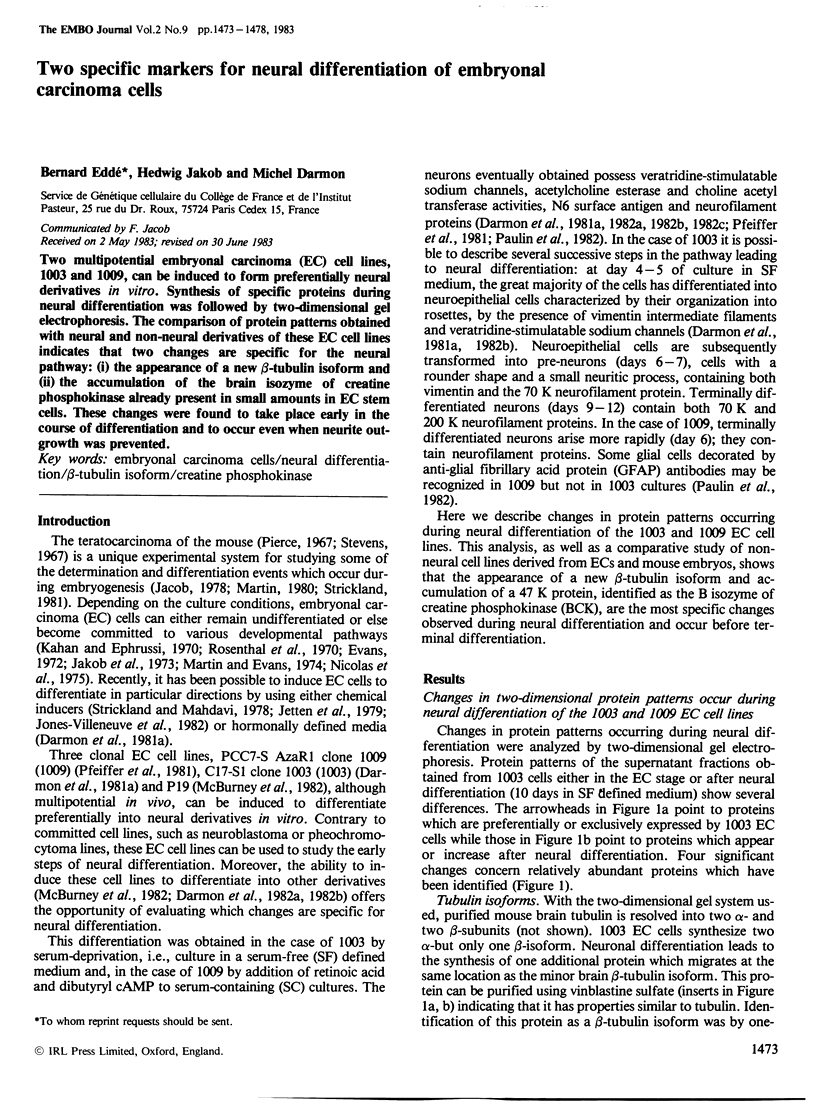
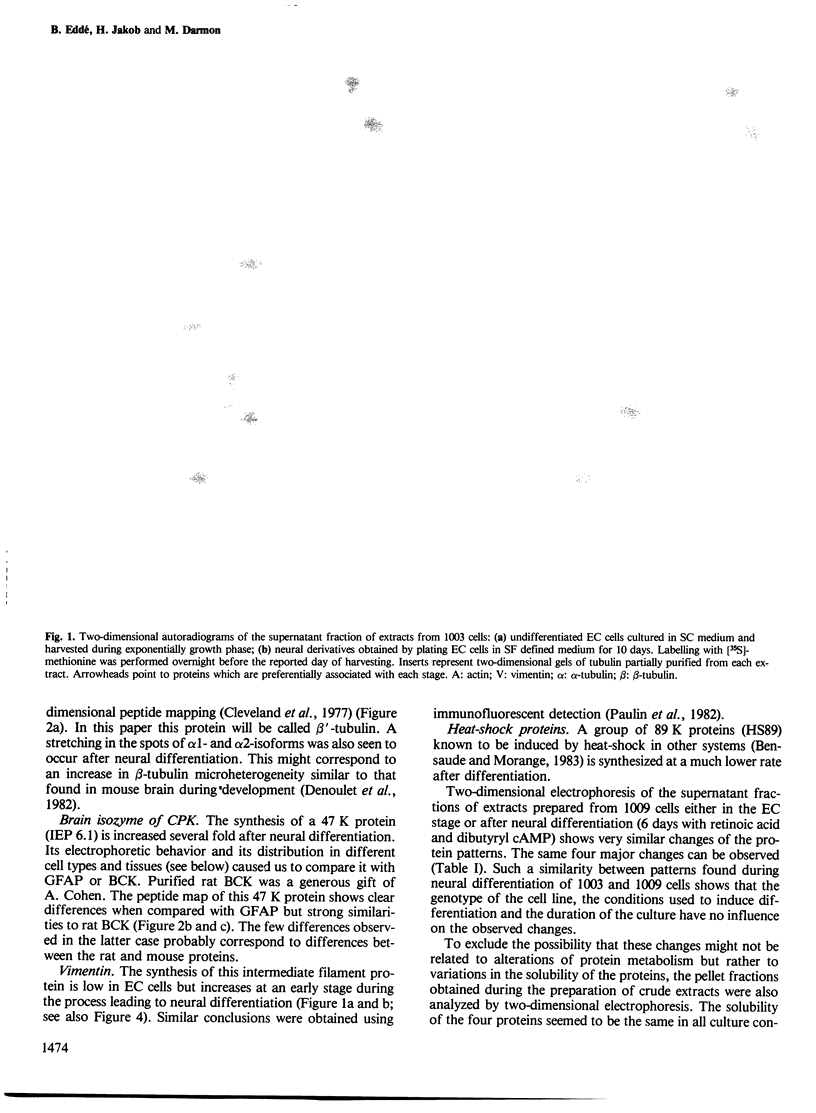
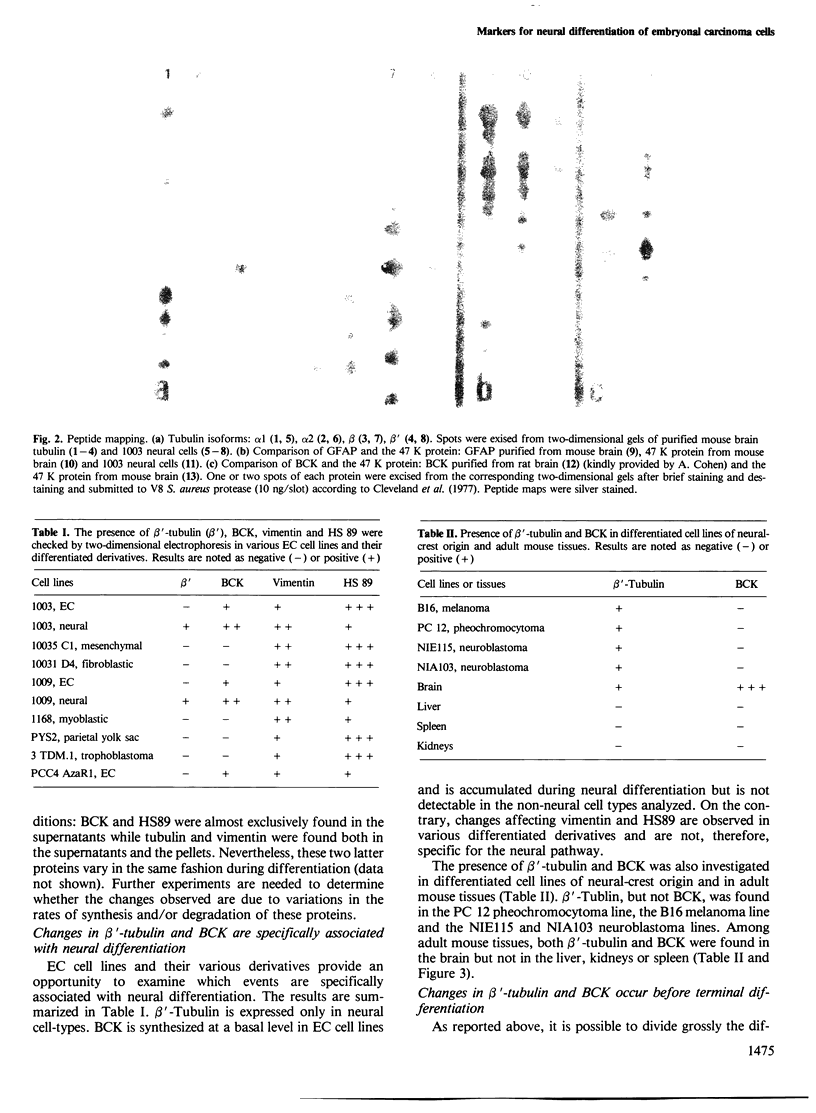
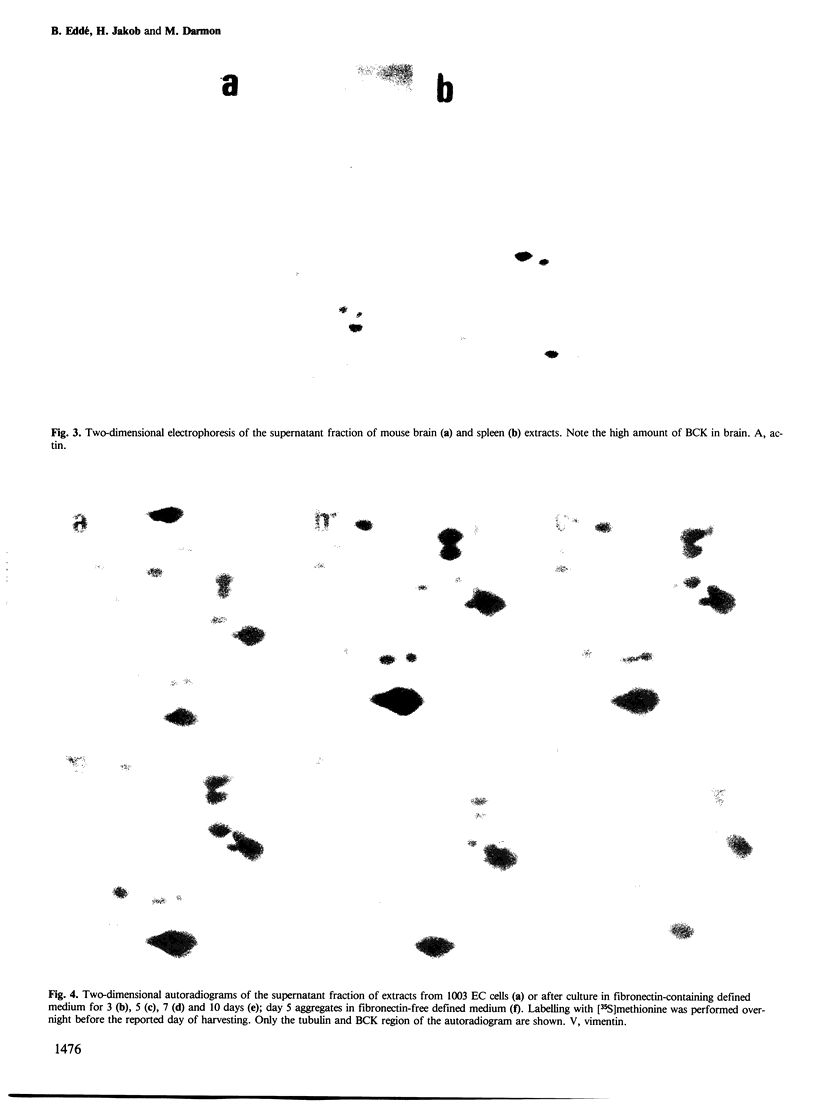

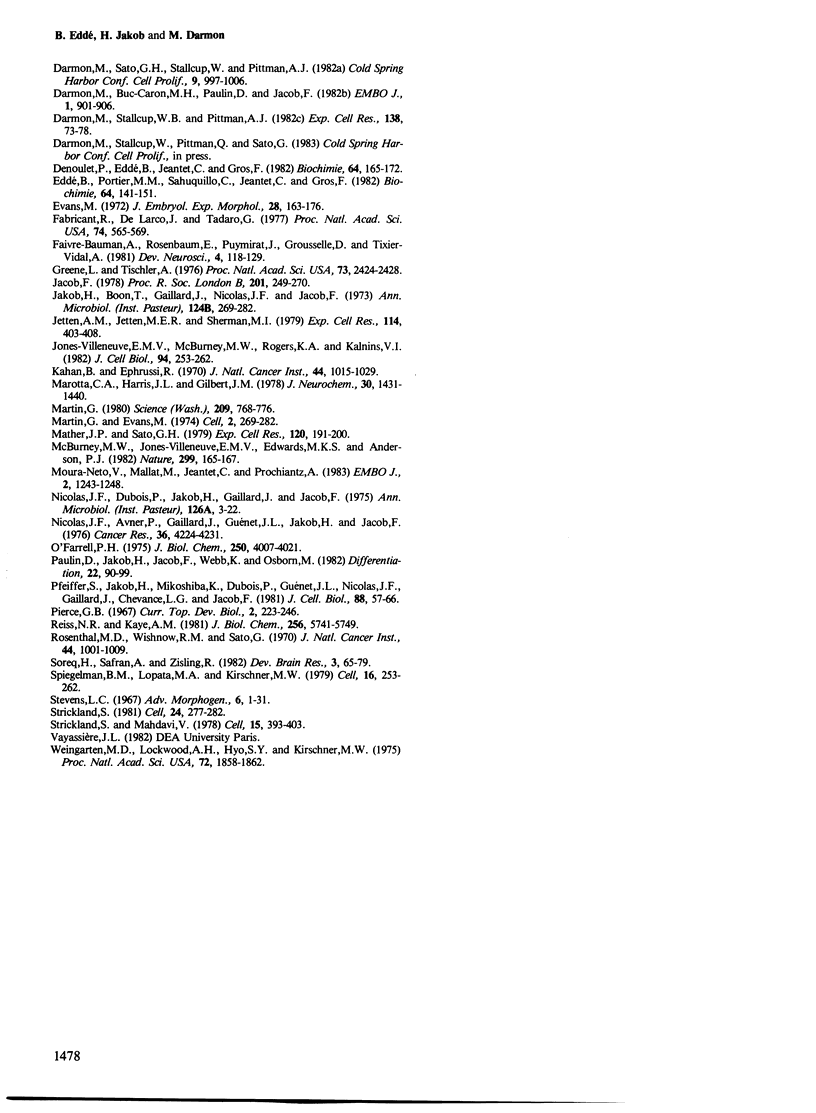
Images in this article
Selected References
These references are in PubMed. This may not be the complete list of references from this article.
- Adamson E. D. Isoenzyme transitions of creatine phosphokinase, aldolase and phosphoglycerate mutase in differentiating mouse cells. J Embryol Exp Morphol. 1976 Apr;35(2):355–367. [PubMed] [Google Scholar]
- Bensaude O., Morange M. Spontaneous high expression of heat-shock proteins in mouse embryonal carcinoma cells and ectoderm from day 8 mouse embryo. EMBO J. 1983;2(2):173–177. doi: 10.1002/j.1460-2075.1983.tb01401.x. [DOI] [PMC free article] [PubMed] [Google Scholar]
- Cleveland D. W., Fischer S. G., Kirschner M. W., Laemmli U. K. Peptide mapping by limited proteolysis in sodium dodecyl sulfate and analysis by gel electrophoresis. J Biol Chem. 1977 Feb 10;252(3):1102–1106. [PubMed] [Google Scholar]
- Darmon M., Bottenstein J., Sato G. Neural differentiation following culture of embryonal carcinoma cells in a serum-free defined medium. Dev Biol. 1981 Jul 30;85(2):463–473. doi: 10.1016/0012-1606(81)90277-3. [DOI] [PubMed] [Google Scholar]
- Darmon M., Buc-Caron M. H., Paulin D., Jacob F. Control by the extracellular environment of differentiation pathways in 1003 embryonal carcinoma cells: study at the level of specific intermediate filaments. EMBO J. 1982;1(8):901–906. doi: 10.1002/j.1460-2075.1982.tb01269.x. [DOI] [PMC free article] [PubMed] [Google Scholar]
- Darmon M., Serrero G., Rizzino A., Sato G. Isolation of myoblastic, fibro-adipogenic, and fibroblastic clonal cell lines from a common precursor and study of their requirements for growth and differentiation. Exp Cell Res. 1981 Apr;132(2):313–327. doi: 10.1016/0014-4827(81)90107-5. [DOI] [PubMed] [Google Scholar]
- Darmon M., Stallcup W. B., Pittman Q. J. Induction of neural differentiation by serum deprivation in cultures of the embryonal carcinoma cell line 1003. Exp Cell Res. 1982 Mar;138(1):73–78. doi: 10.1016/0014-4827(82)90092-1. [DOI] [PubMed] [Google Scholar]
- Denoulet P., Edde B., Jeantet C., Gros F. Evolution of tubulin heterogeneity during mouse brain development. Biochimie. 1982 Mar;64(3):165–172. doi: 10.1016/s0300-9084(82)80466-5. [DOI] [PubMed] [Google Scholar]
- Edde B., Portier M. M., Sahuquillo C., Jeantet C., Gros F. Changes in some cytoskeletal proteins during neuroblastoma cell differentiation. Biochimie. 1982 Feb;64(2):141–151. doi: 10.1016/s0300-9084(82)80416-1. [DOI] [PubMed] [Google Scholar]
- Evans M. J. The isolation and properties of a clonal tissue culture strain of pluripotent mouse teratoma cells. J Embryol Exp Morphol. 1972 Aug;28(1):163–176. [PubMed] [Google Scholar]
- Fabricant R. N., De Larco J. E., Todaro G. J. Nerve growth factor receptors on human melanoma cells in culture. Proc Natl Acad Sci U S A. 1977 Feb;74(2):565–569. doi: 10.1073/pnas.74.2.565. [DOI] [PMC free article] [PubMed] [Google Scholar]
- Faivre-Bauman A., Rosenbaum E., Puymirat J., Grouselle D., Tixier-Vidal A. Differentiation of fetal mouse hypothalamic cells in serum-free medium. Dev Neurosci. 1981;4(2):118–129. doi: 10.1159/000112747. [DOI] [PubMed] [Google Scholar]
- Greene L. A., Tischler A. S. Establishment of a noradrenergic clonal line of rat adrenal pheochromocytoma cells which respond to nerve growth factor. Proc Natl Acad Sci U S A. 1976 Jul;73(7):2424–2428. doi: 10.1073/pnas.73.7.2424. [DOI] [PMC free article] [PubMed] [Google Scholar]
- Jacob F. The Leeuwenhoek Lecture, 1977. Mouse teratocarcinoma and mouse embryo. Proc R Soc Lond B Biol Sci. 1978 May 16;201(1144):249–270. doi: 10.1098/rspb.1978.0044. [DOI] [PubMed] [Google Scholar]
- Jakob H., Boon T., Gaillard J., Nicolas J., Jacob F. Tératocarcinome de la spuris: isolement, culture et propriétés de cellules a potentialités multiples. Ann Microbiol (Paris) 1973 Oct;124(3):269–282. [PubMed] [Google Scholar]
- Jones-Villeneuve E. M., McBurney M. W., Rogers K. A., Kalnins V. I. Retinoic acid induces embryonal carcinoma cells to differentiate into neurons and glial cells. J Cell Biol. 1982 Aug;94(2):253–262. doi: 10.1083/jcb.94.2.253. [DOI] [PMC free article] [PubMed] [Google Scholar]
- Kahan B. W., Ephrussi B. Developmental potentialities of clonal in vitro cultures of mouse testicular teratoma. J Natl Cancer Inst. 1970 May;44(5):1015–1036. [PubMed] [Google Scholar]
- Marotta C. A., Harris J. L., Gilbert J. M. Characterization of multiple forms of brain tubulin subunits. J Neurochem. 1978 Jun;30(6):1431–1440. doi: 10.1111/j.1471-4159.1978.tb10475.x. [DOI] [PubMed] [Google Scholar]
- Martin G. R. Teratocarcinomas and mammalian embryogenesis. Science. 1980 Aug 15;209(4458):768–776. doi: 10.1126/science.6250214. [DOI] [PubMed] [Google Scholar]
- Mather J. P., Sato G. H. The growth of mouse melanoma cells in hormone-supplemented, serum-free medium. Exp Cell Res. 1979 Apr;120(1):191–200. doi: 10.1016/0014-4827(79)90549-4. [DOI] [PubMed] [Google Scholar]
- McBurney M. W., Jones-Villeneuve E. M., Edwards M. K., Anderson P. J. Control of muscle and neuronal differentiation in a cultured embryonal carcinoma cell line. Nature. 1982 Sep 9;299(5879):165–167. doi: 10.1038/299165a0. [DOI] [PubMed] [Google Scholar]
- Moura Neto V., Mallat M., Jeantet C., Prochiantz A. Microheterogeneity of tubulin proteins in neuronal and glial cells from the mouse brain in culture. EMBO J. 1983;2(8):1243–1248. doi: 10.1002/j.1460-2075.1983.tb01576.x. [DOI] [PMC free article] [PubMed] [Google Scholar]
- Nicolas J. F., Avner P., Gaillard J., Guenet J. L., Jakob H., Jacob F. Cell lines derived from teratocarcinomas. Cancer Res. 1976 Nov;36(11 Pt 2):4224–4231. [PubMed] [Google Scholar]
- Nicolas J. F., Dubois P., Jakob H., Gaillard J., Jacob F. Tératocarcinome de la souris: différenciation en culture d'une lignée de cellules primitives a potentialités multiples. Ann Microbiol (Paris) 1975 Jan;126(1):3–22. [PubMed] [Google Scholar]
- O'Farrell P. H. High resolution two-dimensional electrophoresis of proteins. J Biol Chem. 1975 May 25;250(10):4007–4021. [PMC free article] [PubMed] [Google Scholar]
- Paulin D., Jakob H., Jacob F., Weber K., Osborn M. In vitro differentiation of mouse teratocarcinoma cells monitored by intermediate filament expression. Differentiation. 1982;22(2):90–99. doi: 10.1111/j.1432-0436.1982.tb01231.x. [DOI] [PubMed] [Google Scholar]
- Pfeiffer S. E., Jakob H., Mikoshiba K., Dubois P., Guenet J. L., Nicolas J. F., Gaillard J., Chevance G., Jacob F. Differentiation of a teratocarcinoma line: preferential development of cholinergic neurons. J Cell Biol. 1981 Jan;88(1):57–66. doi: 10.1083/jcb.88.1.57. [DOI] [PMC free article] [PubMed] [Google Scholar]
- Pierce G. B. Teratocarcinoma: model for a developmental concept of cancer. Curr Top Dev Biol. 1967;2:223–246. doi: 10.1016/s0070-2153(08)60289-6. [DOI] [PubMed] [Google Scholar]
- Reiss N. A., Kaye A. M. Identification of the major component of the estrogen-induced protein of rat uterus as the BB isozyme of creatine kinase. J Biol Chem. 1981 Jun 10;256(11):5741–5749. [PubMed] [Google Scholar]
- Rosenthal M. D., Wishnow R. M., Sato G. H. In vitro growth and differetiation of clonal populations of multipotential mouse clls derived from a transplantable testicular teratocarcinoma. J Natl Cancer Inst. 1970 May;44(5):1001–1014. [PubMed] [Google Scholar]
- Soreq H., Safran A., Zisling R. Variations in gene expression during development of the rat cerebellum. Brain Res. 1982 Jan;255(1):65–79. doi: 10.1016/0165-3806(82)90076-1. [DOI] [PubMed] [Google Scholar]
- Spiegelman B. M., Lopata M. A., Kirschner M. W. Aggregation of microtubule initiation sites preceding neurite outgrowth in mouse neuroblastoma cells. Cell. 1979 Feb;16(2):253–263. doi: 10.1016/0092-8674(79)90003-5. [DOI] [PubMed] [Google Scholar]
- Strickland S., Mahdavi V. The induction of differentiation in teratocarcinoma stem cells by retinoic acid. Cell. 1978 Oct;15(2):393–403. doi: 10.1016/0092-8674(78)90008-9. [DOI] [PubMed] [Google Scholar]
- Strickland S. Mouse teratocarcinoma cells: prospects for the study of embryogenesis and neoplasia. Cell. 1981 May;24(2):277–278. doi: 10.1016/0092-8674(81)90313-5. [DOI] [PubMed] [Google Scholar]
- Weingarten M. D., Lockwood A. H., Hwo S. Y., Kirschner M. W. A protein factor essential for microtubule assembly. Proc Natl Acad Sci U S A. 1975 May;72(5):1858–1862. doi: 10.1073/pnas.72.5.1858. [DOI] [PMC free article] [PubMed] [Google Scholar]






